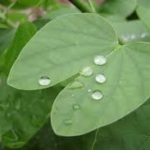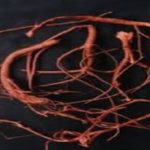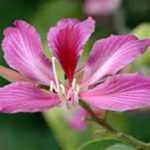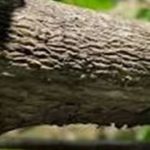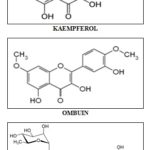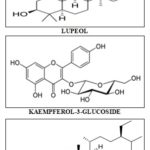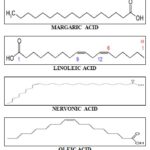PLANT PROFILE, PHYTOCHEMISTRY AND PHARMACOLOGY OF BAUHINIA VARIEGATA LINN. (KACHNAR): AN-OVERVIEW
HTML Full TextPLANT PROFILE, PHYTOCHEMISTRY AND PHARMACOLOGY OF BAUHINIA VARIEGATA LINN. (KACHNAR): AN-OVERVIEW
Raghuveer Irchhaiya 1, Anurag Kumar * 1, Himanshu Gurjar 2, Nikhil Gupta 3, Santosh Kumar 3 and Mayank Kumar 1
Department of Pharmacognosy 1, Department of Pharmaceutics 3, Institute of Pharmacy, Bundelkhand University, Jhansi - 284128, Uttar Pradesh, India.
Department of Pharmacognosy, Institute of Pharmacy 2, LNCT Gwalior - 474002, Madhya Pradesh, India.
ABSTRACT: Bauhinia Variegata Linn. is a widely used medicinal plant distributed in the tropical regions throughout the world. Its various part i.e. flowers, flower buds, stem, roots, stem bark, seeds, leaves have been used since ancient times for the treatment of a large range of diseases such as dysentery, diarrhoea, haemorrhoids, piles, oedema, laxative, anthelmintic, astringent, antileprotic, wound healing, antigoitrogenic, antitumor, antidote for snake poisoning, dyspepsia, carminative etc. The plant contains several flavonoids, steroids, glycosides, reducing sugars as active constituents that bring about its biological effects. Preclinical (in-vivo and in-vitro) investigations have demonstrated pharmacological activities such as antioxidant, hypolipidemic, immunomodulatory, anti-inflammatory, antimicrobial, insecticidal, antibacterial, antidiabetic, antiulcer, hepatoprotective, anti-arthritic, anti-mutagenic, cytotoxic, trypsin inhibitor, anti-goitrogenic. This review represents a detailed survey of literature on plant profile, phytochemistry, and pharmacological activities of Bauhinia variegate Linn.
| Keywords: |
Bauhinia Variegate Linn., Phytochemistry, Pharmacological uses, Kachnar
INTRODUCTION: Rakta Kanchan (Bauhinia Variegata Linn.) is a medium-sized, deciduous tree, found throughout India, ascending to an altitude of 1,300 m in the Himalayas. It is commonly known as Kanchnar in Sanskrit and Mountain Ebony in English. In Sanskrit, the word Kanchnar means “A beautiful glowing lady.” A freshly collected bark of the plant is greyish brown externally and cream colored internally.
The internal surface, however, gradually turns red and on drying becomes brown and smooth. The external surface remains grayish brown and rough due to a large number of exfoliations, transverse cracks, and fissures. On drying, the bark becomes curved and channeled. The fracture is short outside, and fibrous within Leaves are 10-15 cm long, rigidly sub-coriaceous and deeply cordate. The flowers are bisexual, irregular and light magenta.
The pods are long, hard, flat, dehiscent and 10-15 seeded. The various parts of the plant viz., flower buds, flowers, stem, stem bark, leaves, seeds, and roots are practiced in various indigenous systems of medicine and popular among the various ethnic groups in India for the cure of a variety of ailments.
Following a large number of claims on the wide range of folk curative properties of Bauhinia variegata, considerable efforts have been made by the researchers to justify its efficacy as a curative agent through pharmacological investigations 1.
Plant Profile:
Classification:
Kingdom : Plantae – Plants
Subkingdom : Tracheobionta – Vascular plants
Superdivision : Spermatophyta – Seed plants
Division : Magnoliophyta – Flowering plants
Class : Magnoliopsida – Dicotyledons
Subclass : Rosidae
Order : Fabales
Family : Fabaceae – Pea family
Genus : Bauhinia L. – bauhinia P
Species : Bauhinia variegata L. – mountain
ebony 2
Kachnar is Known by Various Names in Different Languages:
Common nam : Mountain ebony
Bengali : Raktakanchan
Hindi : Barial, Gurial, Gwiar, Kachnar,
Kandan, Kaniar, Khairwal,
Khawairaal, Koliar, Padrian
Konkani : Kanchan
Malayalam : Kovidaram, Suvannamandaram,
Unna
Marathi : Kanchan, Raktakanchan, Thaur
Mundari : Burju, Buruju
Sanskrit : Ashmantaka, Asphota, Chamari,
Chamarika,Champavidala,Gandari,
Girija, Kanakaprabha, Kanchanala,
Kanchana,Kanchanara, Kantar,
Karaka, Karbudara, Karbudara,
Kovidara, Kuddala, Raktapushpa,
Shonapushpaka, Suvarnara,
Svalpakkesara, Tamrapushpa,
Uddalaka,Yamalachada,
Yugapatraka, Yugmapatra
Tamil : Mandarai, Segappumandarai,
Semmandarai, Vellaippuvatti.
Telugu : Bodanta, Devakanjanamu,
Kanjanamu, Mandara, Mandari
Urdu : Kachnal
Uriya : Boroda, Kosonaro, Kanjoni,
Burmese : Bwaycheng, Bwechin
Konjono.Ronga-Konjono.
Canarese : Arisinantige, Ayata, Bilikanjivala,
Irkubalitu, Kanjivala, Karalabhogi,
Kempukanjivala, Kempumandara,
Mandara, Ulipe
French : Arbe de saint Thomas, Bauhinie
panache
Morphology: It is medium sized deciduous, fast-growing, sun-loving, flowering tree with a short, dark trunk and hairy branches (thin and ascending). It is usually growing on a rocky soil on hill slopes to sandy loam and loamy soil in the valley, basically, an acidic soil as it doesn’t tolerate salty conditions. The bark of the tree is grayish brown, rough externally (due to the presence of fissures transverse cracks, exfoliations) and smooth surface, creamish color internally (On drying, the color of the inner surface become reddish brown and smooth). Leaves are alternate, linear-lanceolate, running parallel venation, green color, entire margin, smooth and glabrous surface, broad, rounded and bilobed apex, up to 15 cm long, as broad as or broader than long, 9-15 nerved, cleft 1/4 to 1/3 into two obtuse lobes, green color which changes to brown on drying. Leaves and leaflets often show sleep movements. Flowers are bisexual, fragrant, showy, magenta and rosy purple-colored with five petals (4-6 cm long and 2-3 cm wide). Fruits are elongated, pod-like shape, 6-12 inches, dry/hard covering and brownish. Seeds are 15-16 mm long, 11-13 mm wide 3-8.
Microscopical Studies:
FIG. 1: LEAF OF BAUHINIA VARIEGATA L.
Petiole: The microscopical studies of a leaf showed that petiole is divided into the epidermis (single layered, thin-walled rectangular cells, covered with a thin cuticle), which is followed by collenchymatous tissues (two-three layered), then parenchymatous cells (two-four layered, shows abundant solitary calcium oxalate crystals). Vascular bundle (xylem and phloem are well developed) of a petiole are present below the two-five layer of sclerenchymatous tissues.
Lamina: The microscopial studies of a leaf showed that lamina is divided into the upper and lower epidermis (single layered, thin-walled rectangular cells, covered with a thin cuticle), palisade tissue (double layered, columnar cells, spongy tissues are loosely arranged), well developed vascular bundles.
Midrib: The microscopical studies of a leaf showed that midrib is divided into the upper and lower epidermis (single layered, thin-walled rectangular cells, covered with a thin cuticle). This is followed by collenchymatous tissues (two-three layered), then parenchymatous cells (two-four layered, thin-walled, shows abundant solitary calcium oxalate crystals), well developed vascular bundles (shield shape, surrounded by sclerenchymatous tissue) 9.
Quantitative Microscopy of Leaf:
Stomatal index: 5.27
Palisade ratio: 7.6
Vein termination no.: 6.6
Vein islet no.: 8.3
FIG. 2: ROOT OF BAUHINIA VARIEGATA L.
Young Roots: The microscopial studies of roots showed that young roots are divided into periderm (broad and deeper origin, divided into phellum and phelloderm zone. Phellum zone is 150 μm wide and made up of compact and compressed tubular cells. Phelloderm cells are 100 μm wide), secondary phloem (sieve elements and phloem parenchyma cells are arranged randomly and cylindrically), secondary xylem (thin walled fibers, vessels are circular, thin-walled, widest vessels, narrow vessels re 50 and 100 μm in diameter. Primary xylem is also clearly visible).
Thick Roots: The microscopial studies of roots showed that thick roots are divided into periderm (broad and distinct phellum, 3.5 mm thickness, the inner boundary has sclerenchyma elements), secondary phloem (dense mass, wide rays of phloem fibers, radial rows of phloem elements). The vessels of secondary xylem are much wider, thin-walled (solitary, radial multiples) while the fibers of secondary xylem are gelatinous (tangential bands or radial blocks) and normal type.
Very Old and Thick Roots: The microscopial studies of old and thick roots showed that uneven periderm with broken and fissured phellum tissue. The secondary phloem is 350 μm wide, has narrow rays at the outer regions and dilated rays at a certain place. Phloem fibers were scattered in large masses. The sieve elements were randomly distributed 10.
FIG. 3: FLOWER OF BAUHINIA VARIEGATA L.
The microscopial studies of flowers of this plant showed two types of trichomes, unicellular covering trichomes which are pointed at the apex and broad at the base and multicellular glandular trichomes (thin walled and balloon shaped). Pollen grains are like spheroid shape in equatorial view, opened with a circular, large, thickened pore. Ovary part of the flower shows marginal placentation (superior) 11.
FIG. 4: BARK OF BAUHINIA VARIEGATA L.
The microscopial studies of the bark of this plant showed that the uppermost zone of the bark is cork cells which is 12-20 layered, below it, there is a single layer of phellogen which is followed by a wide zone of phelloderm, tangentially elongated to isodiametric cells. This zone also contains lignified fibers and stone cells. The pericyclic fibers found in the bark have a narrow lumen, thickened, lignified, broad walled and tapering ends. The phloem part of the bark is characterized by sieve tubes, companion cells, crystal fibers, phloem fibers, phloem parenchyma and stone cells, transverse by uni-bivariate medullary rays 12.
Phytochemical Properties: The physicochemical characteristics of the oils for B. variegate were investigated , and mean values were found to be: refractive index (40 ºC) 1.4589 ± 0.001, iodine value (g of I2/100g of oil) 84.5 ± 1.6, saponification values (mg of KOH /g of oil ) 191.3 ± 1.9, peroxide value (meq O2 / kg of oil) 1.9 ± 0.6, unsaponifiable matter (%) 0.9 ± 0.4, color (1″ cell) red unit 2.2 ± 0.5, yellow unit 30.0 ± 1.1, moisture (%) 6.7 ± 0.46, ash (%) 4.8 ± 0.1 and fiber (%) 6.9 ± 0.8 13.
Chemical Constituents: The phytochemical screening of n-hexane chloroform, ethyl acetate and methanolic fractions of B. variegata flowers revealed the presence of terpenoids, flavonoids, tannins, saponins, reducing sugars, steroids and cardiac glycosides 14. Phytochemical analysis of non woody aerial parts yielded 6 flavonoids, namely kaempferol, ombuin, kaempferol 7, 4’ – dimethyl ether-3 - o -β – D - glucopyranoside, kaempferol – 3 – o – β – D -glucopyranoside, isorhamnetin – 3 – o – β – D -glucopyranoside and hesperidin together with one triterpene caffeate, 3β trans - (3,4 dihydroxy cinnamoyloxy) olean-12-en-28-oic acid 15.
The stem bark is reported to contain 5, 7 dihydroxy and 5, 7 dimethoxy flavanone - 4- O - L rhamnopyrosyl-β-D-glycopyranosides, Kaempferol -3-glucoside, lupeol, and beta-sitosterol 16-18.
Constituents isolated from the leaves were included lupeol, alkaloids, oil, fat glycoside, phenolics, lignin, saponins, terpenoids, β -sitosterol, tannins, kaempferol-3-glucoside, rutin, quercetin, quercitrin, apigenin, apigenin-7-O-glucoside, amides, carbohydrates, reducing sugars, protein, vitamin C, fibers, calcium, and phosphorus. 19, 20-23
B. variegata seeds contained 18.0 ± 0.9% total oils and 41.9 ± 1.6% total proteins, 0.6 ± 0.1% free fatty acids and 28.4 ± 1.6% carbohydrates. Fatty acids contents of Bauhinia variegata oil (%), were included palmitic 22.1 ± 1.5, palmitoleic 0.4 ± 0.1, margaric 0.3 ± 0.04, stearic 17.5 ± 1.7, oleic (C18:1 cis 9) 13.4 ± 0.8, oleic (C18:1 cis 7) 0.5 ± 0.1, linoleic 42.1 ± 1.8, linolenic (C18:3 n-3) 0.6 ± 0.4, linolenic (C18:3 n-6) 0.5 ± 0.1, arachidic 1.3 ± 0.6 , behenic 0.5 ± 0.2, eicosapentaenoic 0.2 ± 0.4 and nervonic acid 0.6 ± 0.6. The total saturated fatty acids were 41.7%, total monounsaturated fatty acids were 15.1% and total polyunsaturated fatty acids 43.2% of the total lipids 24.
Pharmacological Activities of Bauhinia variegata:
Antibacterial: Parekh et al., evaluated the preliminary antibacterial property from the different extract of this plant against some important bacterial strain such as gram-positive bacteria (Bacillus cereus, Staphylococcus aureus), gram-negative bacteria (Klebsiella pneumonia, E. Coli, Pseudomonas pseudoalcaligenes). The antibacterial activity of bark was determined at three different concentrations, i.e. 10 mg/ml, 5 mg/ml and 2.5 mg/ml in different solvents with increasing polarity by agar well diffusion method. It was concluded from this result that defatted extracts had shown better activity than those without defatting extracts and activity was concentration dependent and polarity of the solvent plays an important role in imparting antibacterial property, and it justifies the traditional use of this plant 25.
Hepatoprotective: Bodakhe et al., investigated the hepatoprotective property of extract of Bauhinia variegata bark (EBV) by oral administration of EBV at the tested dose level (100 and 200 mg/kg) in carbon tetrachloride (CCl) intoxicated male Sprague-Dawley rats weighing between 100-120 g. In this study, liver damage was induced by subcutaneous administration of CCl4 in a suspension of liquid paraffin in the ratio of 1:2 in the lower abdomen of each tested animals. At the end of 13 weeks, the rats were sacrificed by decapitation method, their blood was collected and then serum was separated and subjected to biochemical estimation of parameters such as alanine aminotransferase (ALT), serum aspartate transaminase (AST), alkaline phosphatize (ALP), total lipids, total proteins and gamma-glutamyltranspeptidase (ãGTP). The results of these studies showed that administration of EBV significantly altered the biochemical parameters which got affected in CCl intoxicated male Sprague-Dawley rats. From this study, it was concluded that the extracts of this plant showed significant hepatoprotective activity 26.
Anti-inflammatory: Yadava et al., investigated the anti-inflammatory activity of a novel flavonol glycoside isolated from the ethyl acetate soluble fraction of the ethanolic extract of the roots of this plant in albino rats The isolated compounds show all the characteristics of flavanol glycoside, has molecular formula C28H32O16, the melting point is 214-218 °C. Its structural elucidation was analyzed by spectral analysis and chemical degradations. Evaluation of anti-inflammatory activity of this novel flavonol glycoside was assessed by carrageenan-induced hind paw edema method, i.e. measuring the volume of the paw. Administration of this compound intraperitoneally (i.p.) at the tested dose level of 40 mg/kg into a male or female rats weighing between 140-180 g. Acetylsalicylic acid (ASA) was used as a standard drug to correlate the inflammation inhibitory activity. The results of these studies showed that administration of ethyl acetate soluble fraction of this plant produced moderate anti-inflammatory activity on albino rats. The percentage of inflammation inhibition was 62% as compared to ASA 27.
Rao et al., also investigated the anti-inflammatory activities of the constituents isolated from the non-woody aerial parts of the plant. Effects of these constituents namely, kaempferol (1), obtain(2h), kaempferol 7,4 dimethyl ether 3-O- -D-glucopyranoside (3), kaempferol 3-O- -D-glucopyranoside (4), isorhamnetin 3-O- -D-glucopyranoside (5), hesperidin (6), in addition to triterpenecaffeate and 3 -trans-(3,4-dihydroxy cinnamoyloxy) olean-12-en-28-oic acid (7) were evaluated as an inhibitor of some macrophages functions, i.e. the production of nitric oxide (NO), cytokines such as tumor necrosis factor (TNF), interleukin (IL)-12, involved in the inflammatory process. The result of these studies showed that these compounds significantly inhibited the lipopolysaccharide (LPS) and interferon (IFN-ã) induced production of NO and cytokines (TNF, IL-12) dose-dependently and all the compounds isolated from the plant could be ranked according to their inflammatory inhibitory activity as 7> 1> 2> 5> 6> 3> 4. Compounds 1, 2 and 7 showed dose-dependently 50% inhibition (IC50) of NO, TNF, ILF-12 at a concentration of 30, 50 and 10 μm respectively, while compounds 3, 4, 5 and 6 showed a very less inhibitory effect even at a higher concentration compared to murine peritoneal macrophages.
On the other hand, when the inhibitory effect of these isolated compounds was determined for 24 h on the NO synthesis by LPS/IFN-ã pre-activated murine macrophages, the compounds 1, 4 and 6 inhibits the NO synthesis by 10- 20%, while compounds 3 and 7 failed to inhibit NO synthesis. It was concluded from this finding that compounds present in this plant could be used in the management of inflammatory conditions 28.
Antioxidant Effects: The crude extracts and fractions of B. variegata were evaluated for their antioxidant potential. The antioxidant activity was performed by DPPH radical scavenging assay. Generally, the lowest antioxidant activity was found in the chloroform fraction. The ethyl acetate, methanol, and n-hexane fractions showed moderate scavenging activity as compared to standard quercetin 29.
The ethanolic and aqueous extracts of the stem bark and root of B. variegata L. have assessed for in-vitro antioxidant activity by various methods including, total reducing power, scavenging of various free radicals such as 1,2-diphenyl-2-picrylhydrazyl (DPPH), superoxide, nitric oxide, and hydrogen peroxide. Significant antioxidant activity was observed in all the methods, (P≥0.01) for reducing power and (P≥0.001) for scavenging DPPH, superoxide, nitric oxide, and hydrogen peroxide radicals 30.
Nephroprotective Effect: The antioxidant and nephroprotective effect in gentamicin-induced nephrotoxicity of the ethanolic and aqueous extracts of root of Bauhinia variegata Linn. (200 and 400 mg/kg bw, orally) was examined in rats. Both ethanolic and aqueous root extracts of Bauhinia variegata produced significant free radical scavenging activity. Both extracts produced significant nephroprotective activity in gentamicin-induced nephrotoxicity model as evident by the decrease in elevated serum creatinine, serum urea, urine creatinine and BUN levels, which was further confirmed by histopathological study 31.
The nephroprotective activity of the ethanolic and aqueous extracts of root of Bauhinia variegata at a dose of 400 mg/kg bw was evaluated by gentamicin and cisplatin-induced nephrotoxicity in rats 6T. Both extracts showed nephroprotective activity in both gentamicin and cisplatin-induced nephro-toxicity models as evident by the decrease in serum creatinine, serum urea, urine creatinine and BUN levels in extract treated groups which were elevated by gentamicin and cisplatin in the respective models, which also confirmed by histopathological study 32.
Hypolipidemic Effects: The ethanolic and aqueous extracts of the root of B. variegata (200 and 400 mg/kg body weight) in rats, showed a significant reduction (P≥0.01) in cholesterol and a significant reduction (P≥0.01) in triglyceride level. The VLDL level was also significantly (P≥0.05) reduced, with a significant increase in HDL (19). The anti-hyperlipidemic activity of fractions of total methanol extract of leaves of Bauhinia variegata was investigated against Triton WR-1339 induced hyperlipidemia in rats. Fractions were administered at a dose of 100 mg/kg orally. Butanol fraction showed a significant reduction (p<0.05) in serum cholesterol, triglyceride, LDL, VLDL and increase in HDL level in comparison with standard drug fenofibrate (p<0.05) 33.
The anti-obesity effect of methanolic extract of stem and root barks of Bauhinia variegata was examined in female rats fed with hypercaloric diet. The methanolic plant extract (200 and 400 mg/kg) exhibited a significant hypolipidemic effect with a reduction in the feed intake and body weight. Treatment of obese animals with the methanolic extract of B. variegata exhibited an increased brain serotonin level and high-density lipoprotein with a concomitant decrease in total cholesterol, triglycerides, and low-density lipoprotein. Thus the antiobesity activity of methanolic extract of B. variegata could be attributed to the tendency of the extract to reduce lipid profile and elicit the brain serotonin level 34.
Antiulcer Effects: In gastric ulcer induced by pyloric ligation and in aspirin-induced ulcer model in rats, the ethanolic extract of B.variegata decrease the volume of gastric secretion, total free acidity, and ulcer index 35.
Effect on Wound Healing: Excision and incision wound models in albino Wistar rats, were used to evaluate the wound healing activity of the ethanolic and aqueous extracts of root of Bauhinia variegata at a dose of 200 and 400 mg/kg bw. Both aqueous and ethanolic extracts of root of Bauhinia variegata at both doses produced significant wound healing by excision and incision wound models, which was comparable to that of standard (framycetin) in excision wound model 32.
Molluscicidal Effects: The molluscicidal activity of Bauhinia variegata leaf was studied against vector snail Lymnaea acuminata. The toxicity of the plant was time and concentration-dependent. Among organic extracts, ethanol extracts of the plant were more toxic. The toxicity of B. variegata leaf ethanolic extract was (96h LC3TR50R3T- 14.4 mg/L). The 24 h LC3TR50R 3Tof column purified fraction of B. variegata was 20.3 mg/L. Saponin and quercetin were characterized and identified as active molluscicidal component 36-37.
Antidiabetic: In alloxan hyperglycemic rats, blood glucose was estimated at 0, 1, 2, 3, and 24 h, third day and seventh day after administration of drugs. All the data were analyzed with two-way ANOVA followed by the Bonferroni multiple comparison tests. A value of P<0.05 was considered significant in all cases.
In an acute toxicity study, BVBE was found to be safe up to the level of 2000 mg/kg. Data analysis revealed that BVBE (200 and 400 mg/kg) and metformin did not influence blood glucose in normal rats (P>0.05) [data not showed], suggesting that BVBE, per se, has no hypoglycemic effect. Further, BVBE (200 and 400 mg/kg) and metformin have normalized the impaired glucose tolerance (P<0.01–0.001) with an observable reduction in glucose levels from 60 to 120 min after glucose load. This indicates the efficacy of the BVBE to suppress the elevated blood glucose levels. Alloxan injection induced significant hyperglycemia (P<0.001) (glucose > 250 mg/dl) in 48 h of administration. BVBE (P<0.001) and metformin (P<0.01 to P<0.001) treatment significantly reduced the blood glucose levels in hyperglycaemic animals.
The results revealed the maintenance of blood sugar levels in diabetic rats during the 7 days administration of BVBE throughout the study period. The glucose levels reduced with a single dose on day 1 and decreased further after subsequent doses. The antihyperglycemic effect of BVBE was comparable to metformin. Metformin reduces both fasting and postprandial hyperglycemia by promoting insulin-mediated peripheral glucose utilization and metabolism in adipose tissues and skeletal muscles through up-regulation of glucose transporters, provided that some endogenous insulin is present.
Although, the precise mechanism of the hypoglycaemic action of BVBE remains speculative, the extract may be acting like metformin and improving insulin action at the cellular level. In previous studies, antidiabetic plants exhibited antihyperglycemic effects by enhancing the action of insulin or by increasing the glucose metabolism or glucose homeostasis in diabetic animals 38.
CONCLUSION: Bauhinia variegata is one of the traditional plant used for the treatment of a large range of diseases such as antibacterial, hepatoprotective, anti-inflammatory, antioxidant, nephroprotective, hypolipidemic, antiulcer, wound healing, molluscicidal, antidiabetic, dysentery, diarrhoea, haemorrhoids, piles, oedema, laxative, anthelmintic, astringent, antileprotic, antigoitro-genic, antitumour, antidote for snake poisoning, in dyspepsia and carminative etc. It’s some of the traditional value in curing number of diseases has been confirmed by a pharmacological screening of various parts of this plant. There is still a lack of clinical data for its efficacy, and clinical trials are warranted to justify its traditional use. It also possesses many hidden medicinal properties which can be further evaluated in the future.
ACKNOWLEDGEMENT: The authors are grateful to Dr. S.K. Prajapati H.O.D in the Department of Pharmacy Bundelkhand University, Jhansi, India for providing necessary laboratory facilities and we are also thankful with our deepest core of heart to Dr. Raghuveer Irchhaiya for his valuable guidance.
CONFLICT OF INTEREST: We declare that we have no conflict of interest.
REFERENCES:
- Kumar D, Parcha V and Maithani A: Combined effect on the antihyperlipidemic activity of Bauhinia variegata (linn.) and Salvadora oleoides (decne.) in Triton WR-1339 induced hyperlipidemic rats. World Journal of Pharmaceutical Sciences 2014; 2(5): 428-435.
- https://plants.usda.gov/java/ClassificationServlet?source=display&classid=BAVA
- Kirtiker KR and Basu AD: Indian medicinal plants Oriental Enterprises. Dehradun, India 1935.
- com Traditional medicinal knowledge about common herbs used in the treatment of Leucorrhoea (Safed Pani) in Chhattisgarh, India.
- Natural Habitat: Anonymous, The Wealth of India-a dictionary of Indian raw materials and industrial products. New Delhi: Publication and Information Directorate, CSIR 1988; 53-58.
- Vaidyaratnam PS: Indian Medicinal Plants-a compendium of 500 species. In Eds. Warrier, P.K. V.P.K. Nambier and C. Ramankutty. Chennai: Orient Longman Limited, 1994; 1: 256-260.
- Dey D and Das MN: Pharmacognosy of antidysenteric drugs of Indian medicine Acta Bot Indica 1988; 16: 216-26.
- Prakash A, Prasad S, Wahi SP and Wahi AK: Pharmacognostical study of Bauhinia variegata J. Res Ind Med Yoga. Homoeop 1978; 13(1): 96-97.
- Gupta A, Paarakh PM and Gavani U: Pharmacognostical and Phytochemical screening of Bauhinia variegata Linn leaves. Pharm Res 2009; 2(7): 1196-1198.
- Golwala DK and Patel LD: Golwala, D.K. and L.D. Patel. Linn root. J. Young Pharmacists 2009; 1: 36-41.
- Mali RG, Mahajan SG and Mehta AA: Plant Review Rakta Kanchan (Bauhinia variegata): Chemistry, Traditional and Medicinal uses- a review. Pharmacog Rev 2007; 1: 314-19.
- Mopuru VB, Muntha K, Gunasekar D, Cauxb C and Bodob B: A flavanone and a dihy drodibenzoxepin from Bauhinia variegata. Phytochem 2003; 64(4): 879-82.
- Arain S, Memon N, Rajput MT, Sherazi STH, Bhanger MI and Mahesar SA: Physico-chemical characteristics of oil and seed residues of Bauhinia variegata and Bauhinia linnaei. Pak J Anal Environ Chem 2012; 13(1): 16-21.
- Uddin G, Sattar S and Rauf A: Preliminary phytochemical, in-vitro pharmacological study of Bauhinia alba and Bauhinia variegata Middle-East Journal of Medicinal Plants Research 2012; (4): 75-79.
- Koteswara RY, Shih-Hua F and Yew-Min T: Anti-inflammatory activity of flavonoids and a triterpene caffeate isolated from Bauhinia variegata. Phytotherapy Research 2008; 22: 957-962
- Reddy MV, Reddy MK, Gunasekar D, Caux C and Bodo B: A flavanone and a dihydro dibenzoxepin from Bauhinia variegata. Phytochemistry 2003; 64: 879-882.
- Zhao YY, Cui CB, Cai B, Han B and Sun QS: A new phenanthraquinone from the stems of Bauhinia variegata J Asian Nat Prod Res 2005; 7: 835-838.
- Rajani PG and Ashok P: In-vitro antioxidant and antihyperlipidemic activities of Bauhinia variegata Indian J Pharmacol 2009; 41(5): 227-232.
- Dhale AD: Phytochemical screening and antimicrobial activity of Bauhinia variegata Journal of Ecobiotechnology 2011; 3(9): 4-7.
- The wealth of India; a dictionary of Indian raw materials and industrial products, New Delhi, CSIR, 1998; 2B: 49-52.
- Sharma DD, Gill RS, Chander S and Negi SS: Chemical composition of some fodder tree leaves in the Kangra district. J Res 1966; 3: 438-442.
- Sharma DD, Chawla MS and Negi SS: Chemical composition and nutritive value of bamboo and Kanchar tree leaves. J Res 1968; 5: 253-258.
- Spilkova J and Hubik J: Biologis chewirkungen von flavonoiden II. Pharmazie in unsererzeit 1992; 21(4): 174-182.
- Arain S, Memon N, Rajput MT, Sherazi STH, Bhanger MI and Mahesar SA: Physico-chemical characteristics of oil and seed residues of Bauhinia variegata and Bauhinia linnaei. Pak J Anal Environ Chem 2012; 13(1): 16-21.
- Parekh, Karathia JN and Chanda S: Evaluation of antibacterial activity and phytochemical analysis of Bauhinia variegata Bark. African J Biomed Res 2006; 9: 53-56.
- Bodakhe SH and Ram A: Hepatoprotective properties of Bauhinia variegata bark extract. Yakugaku Zasshi 2007; 127: 1503-07.
- Yadava RN and Reddy VMS: Anti-inflammatory activity of a novel flavonol glycoside from the Bauhinia variegates Natural Product Research 2002; 17: 165-69.
- Rao YK, Fang S and Tzeng Y: Antiinflammatory activities of flavonoids and a triterpene caffeate isolated from Bauhinia variegata. Phytotherapy Res 2008; 22: 957-62.
- Uddin G, Sattar S and Rauf A: Preliminary phytochemical, in-vitro pharmacological study of Bauhinia alba and Bauhinia variegata Middle-East Journal of Medicinal Plants Research 2012; (4): 75-79.
- Rajani PG and Ashok P: In-vitro antioxidant and antihyperlipidemic activities of Bauhinia variegata Indian J Pharmacol 2009; 41(5): 227-232.
- Sharma RK, Rajani GP, Sharma V and Komala N: Effect of ethanolic and aqueous extracts of Bauhinia variegata on gentamicin-induced nephrotoxicity in rats. Ind J Pharm Edu Res 2011; 45(2): 192-198.
- Sharma RK: Pharmacological evaluation of Bauhinia variegate for wound healing and nephroprotective activity. MSc thesis, Rajiv Gandhi University of Health Sciences, Karnataka 2010.
- Kumar D, Parcha V, Maithani A and Dhulia I: Effect and evaluation of antihyperlipidemic activity of fractions of total methanol extract of Bauhinia variegata (Linn.) leaves on Triton WR-1339 (Tyloxapol) induced hyperlipidemic rats. Int J Res Pharm Sci 2011; 2(4): 493-497.
- Balamurugan G and Muralidharan P: Antiobesity effect of Bauhinia variegata bark extract on female rats fed on a hypercaloric Bangladesh J Pharmacol 2010; 5: 8-12.
- Rajkapoor B, Jayakar B, Anandar R and Kavimani S: Antiulcer effect of Bauhinia variegata Linn. in rats. Journal of Natural Remedies 2003; 3(2): 215-217.
- Singh KL, Singh DK and Singh VK: Toxicity of Bauhinia variegata and Mimusops elengi with plant molluscicides against Lymnaea acuminate. J Biol Earth Sci 2012; 2(2): B76-B82.
- Singh KL, Singh DK and Singh VK: Characterization of molluscicidal activity of Bauhinia variegata and Mimusops elengi plant extracts against the Fasciola vector Lymnaea acuminate. Rev In Med Tro Sao Paulo 2012; 54(3): 135-140.
- Zhang XF and Tan BK: Anti-diabetic property of ethanolic extract of Andrographis paniculata in streptozotocin diabetic rats. Acta Pharmacol Sin 2000; 21: 1157-64.
How to cite this article:
Irchhaiya R, Kumar A, Gurjar H, Gupta N, Kumar S and Kumar M: Plant Profile, Phytochemistry and Pharmacology of Bauhinia Variegata Linn. (Kachnar): An-Overview. Int J Pharmacognosy 2014; 1(5): 279-87. doi: 10.13040/IJPSR.0975-8232.1(5).279-87.
This Journal licensed under a Creative Commons Attribution-Non-commercial-Share Alike 3.0 Unported License.
Article Information
1
279-287
682
1511
English
IJP
R. Irchhaiya, A. Kumar *, H. Gurjar, N. Gupta, S. Kumar and M. Kumar
Department of Pharmacognosy, Institute of Pharmacy, Bundelkhand University, Jhansi Uttar Pradesh, India.
anurag.kumar485@gmailmail.com
13 March 2014
16 April 2014
28 April 2014
http://dx.doi.org/10.13040/IJPSR.0975-8232.1(5).279-87
01 May 2014




